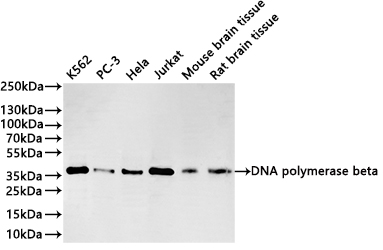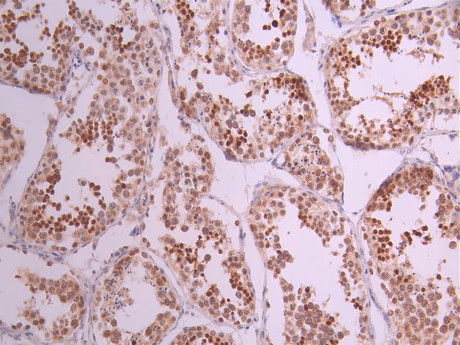POLB Recombinant Monoclonal Antibody
-
中文名稱:POLB Recombinant Monoclonal Antibody
-
貨號:CSB-RA185642A0HU
-
規(guī)格:¥1320
-
圖片:
-
Western Blot
Positive WB detected in: K562 whole cell lysate(30μg), PC-3 whole cell lysate(30μg), Hela whole cell lysate(30μg), Jurkat whole cell lysate(30μg), Mouse brain tissue lysate(30μg), Rat brain tissue lysate(30μg)
All lanes: DNA polymerase beta antibody at 1:1000
Secondary
Goat polyclonal to rabbit IgG at 1/40000 dilution
Predicted band size: 38 kDa
Observed band size: 38 kDa
Exposure time:3min -
IHC image of CSB-RA185642A0HU diluted at 1:100 and staining in paraffin-embedded human testis tissue performed on a Leica BondTM system. After dewaxing and hydration, antigen retrieval was mediated by high pressure in a citrate buffer (pH 6.0). Section was blocked with 10% normal goat serum 30min at RT. Then primary antibody (1% BSA) was incubated at 4°C overnight. The primary is detected by a Goat anti-rabbit polymer IgG labeled by HRP and visualized using 0.05% DAB.
-
-
其他:
產(chǎn)品詳情
-
Uniprot No.:
-
基因名:
-
別名:DNA polymerase beta (EC 2.7.7.7) (EC 4.2.99.-), POLB
-
反應(yīng)種屬:Human, Mouse, Rat
-
免疫原:A synthesized peptide from human POLB protein
-
免疫原種屬:Homo sapiens (Human)
-
標記方式:Non-conjugated
-
克隆類型:Monoclonal
-
抗體亞型:Rabbit IgG
-
純化方式:Affinity-chromatography
-
克隆號:6F4
-
濃度:It differs from different batches. Please contact us to confirm it.
-
保存緩沖液:Preservative: 0.03% Proclin 300
Constituents: 50% Glycerol, 0.01M PBS, PH 7.4 -
產(chǎn)品提供形式:Liquid
-
應(yīng)用范圍:ELISA, WB, IHC
-
推薦稀釋比:
Application Recommended Dilution WB 1:500-1:2000 IHC 1:50-1:200 -
Protocols:
-
儲存條件:Upon receipt, store at -20°C or -80°C. Avoid repeated freeze.
-
貨期:Basically, we can dispatch the products out in 1-3 working days after receiving your orders. Delivery time maybe differs from different purchasing way or location, please kindly consult your local distributors for specific delivery time.
-
用途:For Research Use Only. Not for use in diagnostic or therapeutic procedures.
相關(guān)產(chǎn)品
靶點詳情
-
功能:Repair polymerase that plays a key role in base-excision repair. Has 5'-deoxyribose-5-phosphate lyase (dRP lyase) activity that removes the 5' sugar phosphate and also acts as a DNA polymerase that adds one nucleotide to the 3' end of the arising single-nucleotide gap. Conducts 'gap-filling' DNA synthesis in a stepwise distributive fashion rather than in a processive fashion as for other DNA polymerases.
-
基因功能參考文獻:
- point mutation (C-->G) in position 725 in exon 12, which shifts proline to arginine (P242R).This is a newly reported somatic mutation of pol beta in ovarian carcinoma patients from India PMID: 29524322
- Presently, we describe the preparation of three Pol beta enzymes modified at position 72 with aminooxy or hydrazinyl analogues of lysine. These enzymes form transient covalent bonds with the 5'-dRP moiety of the damaged DNA, in the form of an oxime or hydrazone, respectively PMID: 29625008
- MSH2-MSH3 not only stimulates pol beta to copy through the repeats but also enhances formation of the flap precursor for expansion. PMID: 27546332
- Bond formation and cleavage reactions catalyzed by base excision repair DNA polymerases beta and lambda has been described. PMID: 27992186
- POLB, is located in the mitochondria and plays a significant role in mitochondrial BER, mtDNA integrity and mitochondrial function. [REVIEW] PMID: 29129598
- In the mitochondrial extracts from APTX-/- cells, the strong pol beta lyase and FEN1 activities appear able to repair the blocked BER intermediates with 5'-AMP-dRP groups.Neither pol gamma lyase nor FEN1 alone is able to complement APTX deficiency in the absence of pol beta. PMID: 28973450
- human polymerase beta, accommodates 8-oxoG at the primer terminus opposite cytosine and adenine. PMID: 28449123
- POLB functions in base excision repair to fill in single-nucleotide gaps and exhibits mutation E288K associated with colon cancer. Data suggest that E288K mutant POLB exhibits faster rate of closing of fingers domain combined with slower rate of nucleotide release compared to wild-type POLB; loss of fidelity appears due to defect in interaction of E288K mutant POLB with DNA, resulting in stable, closed enzyme structure. PMID: 28945359
- Unencumbered polymerase beta lyase activity in nucleosome core particles during base excision repair has been reported. PMID: 28911106
- pol beta and BRCA1 appeared to have a functional interaction, observed in both DT40 and human cell lines, in protecting cells against alkylating MMS-induced cytotoxicity; but pol beta had no protective effect in the absence of BRCA1. In vivo and in vitro assays for a base excision repair role of BRCA1 were negative. PMID: 23826138
- hPolbeta discriminates against L-stereochemistry through accumulation of several active site rearrangements that lead to a decreased nucleotide binding affinity and incorporation rate. The two NRTIs escape some of the active site selection through the base and sugar modifications but are selected against through the inability of hPolbeta to complete thumb domain closure. PMID: 28402499
- pol beta contains a specific NLS sequence in the N-terminal lyase domain that promotes transport of the protein independent of its interaction partners. Active nuclear uptake allows development of a nuclear/cytosolic concentration gradient against a background of passive diffusion. PMID: 27956495
- Data suggest that POLB activity is not essential for HIV-1 integration into human macrophages and other cells; limited cellular dNTP pools, but not POLB expression, are primary factor for HIV-1 DNA gap repair, particularly in non-dividing cells. PMID: 28684413
- High DNA polymerase beta mRNA expression is associated with Graves' thyroid tissue. PMID: 27848228
- Polbeta was shown to inhibit the 3'->5' exonuclease activity of APE1 when both enzymes were added simultaneously and to insert the correct nucleotide into the gap arising after hydrolysis of AP site clustered with the benzo[a]pyrene adducts. PMID: 28065385
- Remote mutations induce functional changes in active site residues of human DNA polymerase beta. PMID: 28402631
- It has been concluded based on calculations and the experimental pH profile that the most likely path for the wild-type (WT) and the D256E and D256A mutants is a proton transfer (PT) to the bulk, although the WT may also use a PT to Asp 256. PMID: 27488241
- The homozygous/heterozygous genotypes containing the African allele showed higher POLB expression than the homozygous white allele genotype (P < .001). A replication study using a GEO data set validated all 5 eQTLs and also showed a statistically significant difference in POLB expression based on genetic ancestry (P = .002). PMID: 27906459
- HMGB1 stimulates activity of DNA polymerase beta on nucleosome substrates in the process of base excision repair. PMID: 28098985
- The results help to define the tolerance of DNA Pol beta to subtle local structural and functional alterations derived from lysine 72. PMID: 28005340
- PolB is ubiquitylated on amino-acid residues K206 and K244 when not in a complex with XRCC1. PMID: 25423885
- a substitution mutation, R152C, impairs Pol beta polymerase activity and DNA base excision repair efficiency. PMID: 26760506
- These results suggest that polbeta gene with G648C mutation in surgically resected esophagus may be clinically useful for predicting responsiveness to chemotherapy in patients with esophageal cancer PMID: 26334617
- Data show that esophageal carcinoma (EC) cells expressing the DNA polymerase beta K167I variant to be sensitive to DNA damaging agents. PMID: 26527528
- Pol lambda can incorporate rNMPs opposite normal bases or 8-oxo-G, and with a different fidelity. Further, the incorporation of rNMPs opposite 8-oxo-G delays repair by DNA glycosylases. PMID: 26917111
- POLB was pinpointed as a target gene of miR- 499. Additionally, we identified that miR-499 can enhance cisplatin's function of inhibiting proliferation and of promoting apoptosis in EC9706 and KYSE30 cell lines. PMID: 26159783
- Since APE1, XRCC1 and POLB proteins operate downstream the same DNA repair pathway to eliminate DNA oxidative damage, their expression above basal levels found in our study could reveal excessive oxidative stress in high-grade bladder tumors. PMID: 26238022
- findings indicate that the IKBKB and POLB SNPs confer no genetic predisposition to SLE risk in this Chinese Han population PMID: 26167925
- The structure of pol beta in binary complex with template 8-oxoG in a base excision repair substrate, is reported.[Dna polymerase beta] PMID: 22178760
- Fen1 significantly stimulated trinucleotide repeats expansion by Pol beta, but not by the related enzyme Pol lambda. PMID: 25687118
- Data show that tongue cancer resistance-associated protein 1 (TCRP1) contributes to cisplatin (DDP) resistance via the increased expression of DNA polymerase beta subunit (Pol beta) in lung cancer cells. PMID: 25260657
- DNA polymerase beta catalyzes lesion bypass across benzo[a]pyrene-derived DNA adduct in an error prone manner. PMID: 25460917
- HSP90 regulates DNA repair by interaction between XRCC1 and DNA polymerase beta. PMID: 25423885
- The results suggest that POLB gene with T889C mutation in surgically resected primary gastric tissues may be clinically useful for predicting responsiveness to chemotherapy in patients with GC. PMID: 25561897
- A novel method for monitoring functional lesion-specific recruitment of repair proteins in live cells. PMID: 25879709
- The study provides new insights into the spontaneous replication error and the replication fidelity mechanisms of DNA polymerase beta. PMID: 25200079
- structural analysis of the mechanism of polbeta-mediated cisplatin resistance PMID: 25237188
- analysis of DNA polymerase beta activation PMID: 25261471
- Upregulation of DNA polymerase beta is associated with chemoresistance in esophageal carcinoma. PMID: 24460306
- that polbeta silencing increased the sensitivity of esophageal carcinoma cells to radiation therapy PMID: 25015190
- POLB deficiency is associated with aggressive breast cancer and poor prognosis. PMID: 24462520
- Pols beta from human cells to act on DNA containing an isolated 2-deoxyribonolactone, as well as when the lesion comprises the 5'-component of a tandem lesion. PMID: 23101935
- S229L colon tumor-associated variant of DNA polymerase beta induces cellular transformation as a result of decreased polymerization efficiency PMID: 24668809
- variant metal-ion routes in DNA polymerase beta's conformational pathways PMID: 24511902
- This study reveals that DNA polymerase beta catalysis across N7-methylguanine is slow, yet highly accurate. PMID: 24966350
- shown that germline and tumor-associated variants of DNA polymerase beta (Pol ss) catalyze aberrant base excision repair (BER) that leads to genomic instability and cellular transformation. PMID: 24348210
- results identified nine types of mutations within polbeta cDNA in esophageal squamous cell carcinoma patients with four mutations related to patient survival PMID: 23959474
- We conclude that distinct mutations of the triple pol b mutant are responsible for the loss of activity, lower fidelity, and instability observed in vitro. PMID: 23877444
- Comparison with published structures provides insight into the structural rearrangements within pol b that occur during the process of nucleotide discrimination. PMID: 24133209
- Upregulation of transcriptional activity induced by mutations in the DNA polbeta promoter may be one of the molecular mechanisms mediating abnormal overexpression of DNA polbeta in esophageal squamous cell carcinoma. PMID: 23749489
顯示更多
收起更多
-
亞細胞定位:Nucleus. Cytoplasm. Note=Cytoplasmic in normal conditions. Translocates to the nucleus following DNA damage.
-
蛋白家族:DNA polymerase type-X family
-
數(shù)據(jù)庫鏈接:
Most popular with customers
-
-
YWHAB Recombinant Monoclonal Antibody
Applications: ELISA, WB, IHC, IF, FC
Species Reactivity: Human, Mouse, Rat
-
Phospho-YAP1 (S127) Recombinant Monoclonal Antibody
Applications: ELISA, WB, IHC
Species Reactivity: Human
-
-
-
-
-





















